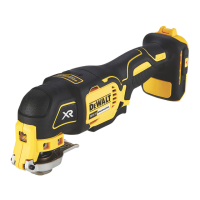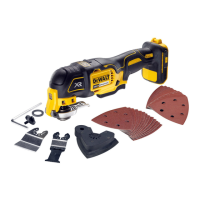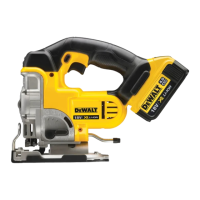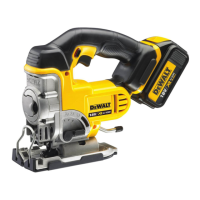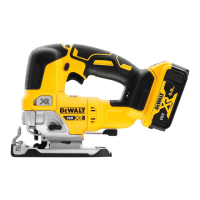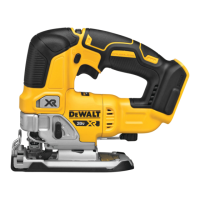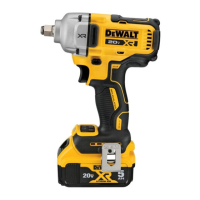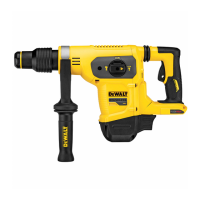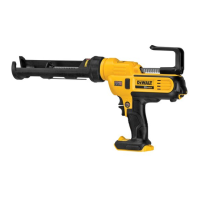13
ENGLISH
Installing/Removing Accessories (Fig.C–M,Q)
Tool-free Accessory clamp (Fig.C–E)
The DCS355, DCS356 features a quick change accessory system.
This allows for faster accessory changes without the need for
wrenches or hex keys like other oscillating toolsystems.
1. Grasp the tool and squeeze the accessory clamping lever
3
as shown in FigureC.
2. Clean any residual debris from the tool shaft and the
accessoryholder.
3. Slide the accessory between the shaft
22
and the accessory
holder making sure the accessory engages all eight pins on
the holder and is flush with the shaft. Ensure the accessory is
oriented as shown in FigureD.
4. Release the accessory clamplever.
NOTE: Some accessories, such as scrapers and blades can be
mounted at an angle if required as shown in FigureE.
Installing/Removing Sanding Sheets (Fig.F)
A diamond shaped platen uses a hook and loop adhesion
system to attach the sanding sheets. The platen allows you to
use it on large flat surfaces and tight spots orcorners.
Inserting and Removing the Battery Pack
from the Tool (Fig. B)
NOTE: Make sure your battery pack
8
is fullycharged.
To Install the Battery Pack into the Tool Handle
1. Align the battery pack
8
with the rails inside the tool’s
handle (Fig. B).
2. Slide it into the handle until the battery pack is firmly seated
in the tool and ensure that you hear the lock snap intoplace.
To Remove the Battery Pack from the Tool
1. Press the release button
9
and firmly pull the battery pack
out of the toolhandle.
2. Insert battery pack into the charger as described in the
charger section of thismanual.
Fuel Gauge Battery Packs (Fig. B)
Some DeWALT battery packs include a fuel gauge which consists
of three green LED lights that indicate the level of charge
remaining in the batterypack.
To actuate the fuel gauge, press and hold the fuel gauge
button
11
. A combination of the three green LED lights will
illuminate designating the level of charge left. When the level of
charge in the battery is below the usable limit, the fuel gauge
will not illuminate and the battery will need to berecharged.
NOTE: The fuel gauge is only an indication of the charge left on
the battery pack. It does not indicate tool functionality and is
subject to variation based on product components, temperature
and end‑userapplication.
WARNING: Risk of lacerations or burns. Do not touch
the sharp edges of accessories at any time. Do not
touch workpiece or blade immediately after operating the
tool. They can become very hot. Handle carefully. Always
allow accessories and workpiece to cool beforehandling.
1. Attach the sanding platen
23
as described under
Installing/RemovingAccessories.
2. Align the edges on the sanding sheet, with the edge of
the sanding platen and press the sanding sheet
24
onto
theplaten.
3. Firmly press the base with the sanding sheet attached
against a flat surface and briefly switch the tool on. This
provides for good adhesion between the platen and the
sanding sheet and also helps to prevent prematurewear.
4. When the tip of the sanding sheet becomes worn, detach
the sheet from the platen, rotate andreapply.
Attaching Accessories Using the Universal
Adapter (Fig.G)
CAUTION: To avoid injury, do not use any accessory
for an application where the adaptor may fail to hold
theaccessory.
CAUTION: Read and follow all manufacturers' safety
warnings for any accessories used with thistool.
CAUTION: To avoid injury, ensure adaptor and accessory
are securelytightened.
Non‑DeWALT accessories can be attached using the
universaladaptor.
1. Place the washer
20
on thetool.
2. Place accessory
12
on towasher.
3. Tighten and secure adaptor nut
18
using hex wrench
16
.
Attaching the Cut Guide (Fig.H–M)
The depth/cut guide allows you to precisely cut material at a
specified depth and more accurately track a marked cutline.
1. Attach the cut guide block
6
by inserting the accessory
tabs
13
on the guide into the accessory side mount slots
5
on the main body of thetool.
NOTE: The depth/cut guide can be attached to either side
of thetool.
2. Secure the block to the main body with the supplied
screw
15
and washer
21
. Tighten with the supplied hex
wrench
16
.
Depth Guide (Fig.I, J)
This feature allows you to precisely cut material at a
specifieddepth.
1. Insert the guide arm
7
as shown in FigureI into the front
slot on the guide block
6
.
2. Adjust the length of the guide by pulling out or pushing
inward to achieve the desired cut depth as shown in
FigureJ.
3. Secure the guide in place by turning the depth/cut
adjustment knob
14
clockwise. To release the guide turn
the depth/cut adjustment knobcounterclockwise.
Cut Guide (Fig.K–M)
This feature allows you to more accurately track a marked
cutline.
1. Insert the guide arm
7
as shown in FigureK into the slots
on the left and right sides of the guide block
6
.
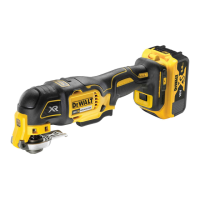
